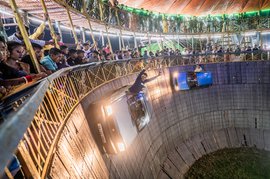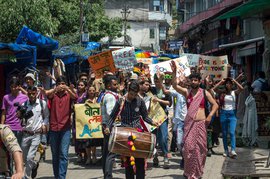“ Maine kabhi do board ek jaisa nahi banaya [I have never painted two boards the same way],” says Sheikh Jalaluddin Kamaruddin, a painter of sign boards in Ahmedabad. He has painted all the sign boards in Gheekanta, a busy locality known for scissor manufacturers. Despite the many shops all selling the same product, Jalalludin’s signs ensure that every shop has its own visual identity.
The work of the veteran painter can be seen on " deewar, dukaan aur shutter [walls, shops, and shop shutters]," and also as backdrops for films. A sign board painter must know how to draw and paint the script letters of many local languages. At a jeweller’s shop in Ahmedabad's Manek Chowk, a sign in four languages – Gujarati, Hindi, Urdu and English – is still displayed, half a century later.
Jalaluddin says that painting came naturally to him. At 71, he is one of the oldest sign board painters in Ahmedabad, going by the name 'JK Painter'. He says he doesn’t get as much work as he used to when he started painting signs 50 years ago.
The veteran painter studied till Class 7 and can paint sign boards in five languages – Gujarati, English, Hindi, Urdu and Arabic. After leaving school he worked as a rope maker, book binder and garage mechanic, before learning painting at Raheem’s shop in Dalgharwad market.
Although in his seventies, Jalaluddin can still
carry his 20 kilo
ghoda
(ladder) to
paint sign boards on site. but since his bypass operation his doctor has
advised him not to carry heavy weight. So his onsite work has reduced, and he only
paints at his shop. “My knees also hurt if I stand on the ladder for too long,”
he says but quickly adds, “as long as my hands and feet work I will continue
doing this work.”


Left: Jalaluddin in front of sign boards he has painted. Right: A board in Manek Chowk displays the shop's name in four languages – Gujarati, Hindi, Urdu and English


The sign boards painted by Jalaluddin for scissor manufacturers in Gheekanta (left) and for a stationary shop (right)
He recently painted a sign board for a customer, Muntazir Pisuwala who owns a crockery store in Ahmedabad’s Teen Darwaza area. He was paid Rs. 3,200 for the sign and Pisuwala says the process is often a collaborative one: “We chose the colour and everything else together.”
Jalaluddin set up his shop in front of his house in the compound of the Pir Qutub Masjid. On a sunny, humid afternoon, he has come back to his shop after lunch and a quick nap. He is dressed in a white shirt splashed with paint, and is all set to begin work on a board to display the room tariffs for a hotel in the old city. He uses a rope and steel chair with no armrest so he can move his arms freely while seated.
He sets his hand-made wooden easel to the right height and places a blank board on it. He must follow the old board made by him 25 years ago that has worn out, and so the owner commissioned him to make a new one in exactly the same style.
“I apply three coats of paint,” he says, on the wooden board which has already been painted white. According to him this creates, “ bilkul finishing wala colour aayega [the board will have the perfect colour once finished].” It takes a day for each coat of paint to dry.
The styles of different painters of boards is
noticeable. “Their style echoes the ornamental and layered Indian visual
language, found in our sculptures, temples and prints,” says Tarun Deep
Girdher, professor of graphic design at the National Institute of Design
(NID), Ahmedabad.


Jalaluddin starts the process by applying coats of white paint on the sign board (left) using 30-year-old squirrel hair brushes (right)


The veteran painter uses a wooden ruler to ensure straight lines (left) and then directly starts drawing the letters with paint (right)
Jalaluddin glances at the text that he is copying. “I see how big or small the letters need to be,” he says. “ Kuch drawing nahin karta hu, line banaake likhna chalu, kalam se [I don’t draw anything. I just make rough lines and start writing with the brush].” The master painter doesn’t write out the letters in pencils first, but only uses a wooden ruler to ensure straight lines
Removing old squirrel hair brushes from a paintbox he informs me proudly that, “I made my own paintbox.” Jalaluddin also works as a carpenter and made this box in 1996. He isn’t happy with the new plastic brushes in the market and prefers to use his approximately 30 year-old brushes stored in his handmade paint box.
Selecting two brushes he cleans them with turpentine and opens a can of red paint. The bottle is 19 years old. Using his scooter’s key, he mixes turpentine till it is the right consistency. He then flattens the brush, plucking out any stray hairs.
Jalaluddin says he’s grateful that his hands don’t shake at this age; their steadiness being integral to his work. It takes him five minutes to write the first letter but it's not the right height. When occasional mistakes like this do occur, he erases it while it is wet and redoes the part. “ Humko jarasa bhi bahar niklo nahi chalega [We don’t like it even if the paint comes out a little bit],” he says.
He says that customers come back to him for the neatness and precision in his work. His mastery is in the diamond type, which involves lettering in 3D which gives it its shiny, diamond like effect. It is fairly complex, and Jalal explains that he has to get the light, shadows and midtones exactly right to make it look convincing.
This signboard will take him another day to
finish, and for two days of work, he will charge Rs. 800-1,000 rupees for the
job. Jalauddin charges anywhere between 120-150/- per sq.ft, a standard rate.
But he doesn’t give a monthly estimate: “
Hisaab likhoge
to ghata hi hoga, isliye behisaab rehta hu
[If I write my accounts,
I’ll always be in loss so I never calculate].”


Left: Jalaluddin's mastery is in the diamond type, which involves lettering in 3D which gives it its shiny, diamond like effect. Right: 'Their [sign board painters] style echoes the ornamental and layered Indian visual language, found in our sculptures, temples and prints,' says Tarun Deep Girdher, a professor of graphic design


Left: Hand-painted sign board for a digital printing shop in Manek Chowk, Ahmedabad. Right: 'Hand-made signs last a lifetime, digital ones don’t,' says Gopalbhai Thakkar, owner of a digital printing shop
Jalaluddin has three children, two boys and a girl. His elder son took up painting sign boards, but soon left the profession and now works at a tailoring shop.
Like Jalaluddin’s children, many young people are leaving the profession. Today, the art of hand-painting boards is a dying one. “ Computer ne haath kaat diye painter ke [Computers replaced the painter’s work],” says Aashiq Hussain, who started painting signboards 35 years ago. Dhirubhai, a second-generation painter estimates that there are only 50 sign board painters left in Ahmedabad.
Digital prints on flex are widely available and now hardly anyone wants hand-painted boards. So to supplement his income, painter Aashiq also drives an autorickshaw.
In what is an unexpected recognition of hand
painted signs, some digital printing shop owners like Gopalbhai Thakkar who can
easily print a sign for themselves, say they prefer to use hand-made signs,
despite the higher cost. “
Ye lifetime
chalta hai, woh nahi chalega
[Hand-made signs last a lifetime,
digital ones don’t].”


Left: Aashiq Hussain now drives an autorickshaw to supplement his income. Right: Arvindbhai Parmar, a veteran sign board painter from Adalaj bought a plexi cutter machine and now prints signs


Left: The 75-year-old Hussainbhai Hada with his son and grandson at their digital flex and sticker printing shop. Right: Vali Mohammed Mir Qureshi works with digital signs and only gets occasional jobs to paint signs
Many painters have also adapted to the new technology. Arvindbhai Parmar has been painting sign boards in Adalaj, 10 kms away from Gandhinagar for 30 years. Seven years ago he bought a plexi cutter machine which prints stickers. It was a large investment, the machine cost him Rs. 25,000 and the computer another 20,000 rupees. He learnt how to use a computer from his friends.
The machine cuts stickers and alphabets on radium paper, which is then stuck on metal. But Arvindbhai says he prefers painting by hand as either the computer or the machine keeps breaking down and we have to keep repairing them.
Vali Mohammed Mir Qureshi, a 41-year-old sign board painter, also works with digital signs now. He occasionally gets jobs to paint sign boards.
Vali, like many other painters, was taught and mentored by Hussainbhai Hada. But the 75-year-old says that his own children don’t know the craft. His son, Haneef and grandsons, Hazir and Amir run a business of designing and printing stickers, signs and flexes in their shop in Gandhinagar’s Sector 17.
“ Aur logo ko karna chahiye [More people should paint sign boards],” Hussainbhai says.



